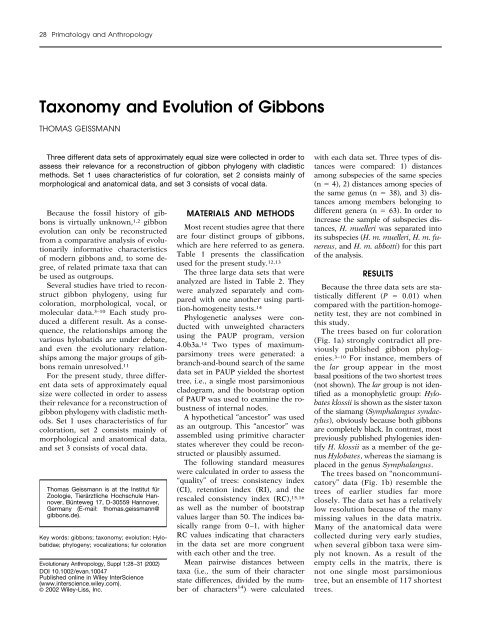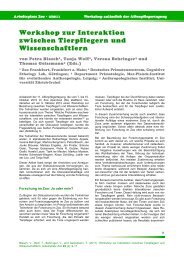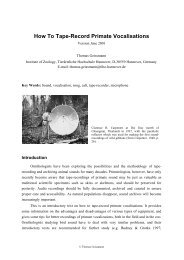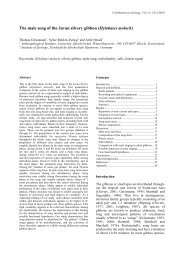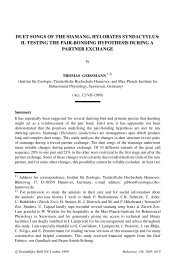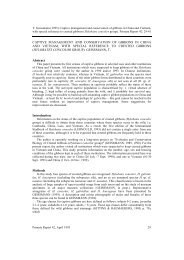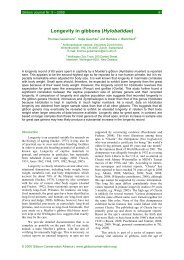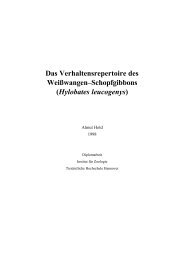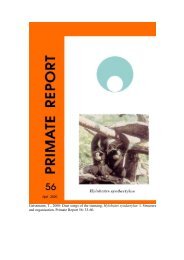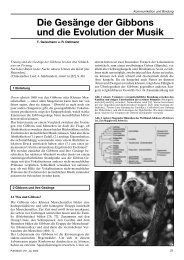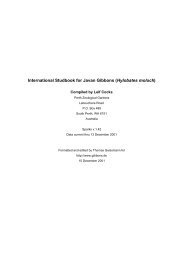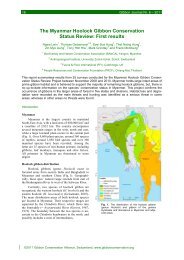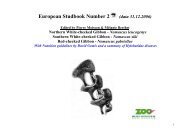Taxonomy and Evolution of Gibbons
Taxonomy and Evolution of Gibbons
Taxonomy and Evolution of Gibbons
You also want an ePaper? Increase the reach of your titles
YUMPU automatically turns print PDFs into web optimized ePapers that Google loves.
28 Primatology <strong>and</strong> Anthropology<strong>Taxonomy</strong> <strong>and</strong> <strong>Evolution</strong> <strong>of</strong> <strong>Gibbons</strong>THOMAS GEISSMANNThree different data sets <strong>of</strong> approximately equal size were collected in order toassess their relevance for a reconstruction <strong>of</strong> gibbon phylogeny with cladisticmethods. Set 1 uses characteristics <strong>of</strong> fur coloration, set 2 consists mainly <strong>of</strong>morphological <strong>and</strong> anatomical data, <strong>and</strong> set 3 consists <strong>of</strong> vocal data.Because the fossil history <strong>of</strong> gibbonsis virtually unknown, 1,2 gibbonevolution can only be reconstructedfrom a comparative analysis <strong>of</strong> evolutionarilyinformative characteristics<strong>of</strong> modern gibbons <strong>and</strong>, to some degree,<strong>of</strong> related primate taxa that canbe used as outgroups.Several studies have tried to reconstructgibbon phylogeny, using furcoloration, morphological, vocal, ormolecular data. 3–10 Each study produceda different result. As a consequence,the relationships among thevarious hylobatids are under debate,<strong>and</strong> even the evolutionary relationshipsamong the major groups <strong>of</strong> gibbonsremain unresolved. 11For the present study, three differentdata sets <strong>of</strong> approximately equalsize were collected in order to assesstheir relevance for a reconstruction <strong>of</strong>gibbon phylogeny with cladistic methods.Set 1 uses characteristics <strong>of</strong> furcoloration, set 2 consists mainly <strong>of</strong>morphological <strong>and</strong> anatomical data,<strong>and</strong> set 3 consists <strong>of</strong> vocal data.Thomas Geissmann is at the Institut fürZoologie, Tierärztliche Hochschule Hannover,Bünteweg 17, D-30559 Hannover,Germany (E-mail: thomas.geissmann@gibbons.de).Key words: gibbons; taxonomy; evolution; Hylobatidae;phylogeny; vocalizations; fur coloration<strong>Evolution</strong>ary Anthropology, Suppl 1:28–31 (2002)DOI 10.1002/evan.10047Published online in Wiley InterScience(www.interscience.wiley.com).© 2002 Wiley-Liss, Inc.MATERIALS AND METHODSMost recent studies agree that thereare four distinct groups <strong>of</strong> gibbons,which are here referred to as genera.Table 1 presents the classificationused for the present study. 12,13The three large data sets that wereanalyzed are listed in Table 2. Theywere analyzed separately <strong>and</strong> comparedwith one another using partition-homogeneitytests. 14Phylogenetic analyses were conductedwith unweighted charactersusing the PAUP program, version4.0b3a. 14 Two types <strong>of</strong> maximumparsimonytrees were generated: abranch-<strong>and</strong>-bound search <strong>of</strong> the samedata set in PAUP yielded the shortesttree, i.e., a single most parsimoniouscladogram, <strong>and</strong> the bootstrap option<strong>of</strong> PAUP was used to examine the robustness<strong>of</strong> internal nodes.A hypothetical “ancestor” was usedas an outgroup. This “ancestor” wasassembled using primitive characterstates wherever they could be reconstructedor plausibly assumed.The following st<strong>and</strong>ard measureswere calculated in order to assess the“quality” <strong>of</strong> trees: consistency index(CI), retention index (RI), <strong>and</strong> therescaled consistency index (RC), 15,16as well as the number <strong>of</strong> bootstrapvalues larger than 50. The indices basicallyrange from 0–1, with higherRC values indicating that charactersin the data set are more congruentwith each other <strong>and</strong> the tree.Mean pairwise distances betweentaxa (i.e., the sum <strong>of</strong> their characterstate differences, divided by the number<strong>of</strong> characters 14 ) were calculatedwith each data set. Three types <strong>of</strong> distanceswere compared: 1) distancesamong subspecies <strong>of</strong> the same species(n 4), 2) distances among species <strong>of</strong>the same genus (n 38), <strong>and</strong> 3) distancesamong members belonging todifferent genera (n 63). In order toincrease the sample <strong>of</strong> subspecies distances,H. muelleri was separated intoits subspecies (H. m. muelleri, H. m. funereus,<strong>and</strong> H. m. abbotti) for this part<strong>of</strong> the analysis.RESULTSBecause the three data sets are statisticallydifferent (P 0.01) whencompared with the partition-homogenetitytest, they are not combined inthis study.The trees based on fur coloration(Fig. 1a) strongly contradict all previouslypublished gibbon phylogenies.3–10 For instance, members <strong>of</strong>the lar group appear in the mostbasal positions <strong>of</strong> the two shortest trees(not shown). The lar group is not identifiedas a monophyletic group: Hylobatesklossii is shown as the sister taxon<strong>of</strong> the siamang (Symphalangus syndactylus),obviously because both gibbonsare completely black. In contrast, mostpreviously published phylogenies identifyH. klossii as a member <strong>of</strong> the genusHylobates, whereas the siamang isplaced in the genus Symphalangus.The trees based on “noncommunicatory”data (Fig. 1b) resemble thetrees <strong>of</strong> earlier studies far moreclosely. The data set has a relativelylow resolution because <strong>of</strong> the manymissing values in the data matrix.Many <strong>of</strong> the anatomical data werecollected during very early studies,when several gibbon taxa were simplynot known. As a result <strong>of</strong> theempty cells in the matrix, there isnot one single most parsimonioustree, but an ensemble <strong>of</strong> 117 shortesttrees.
Primatology <strong>and</strong> Anthropology 29Diploid NumberTABLE 1. Main Divisions <strong>of</strong> Genus Hylobates aOther DivisionGenus<strong>of</strong> Chromosomes Names Species English-Language NameHylobates 44 lar group H. agilis b Agile gibbonH. klossii Kloss’s gibbonH. lar White-h<strong>and</strong>ed gibbonH. moloch Silvery gibbonH. muelleri c Müller’s gibbonH. pileatus Pileated gibbonBunopithecus 38 B. hoolock HoolockNomascus 52 concolor group, N. concolor Western black crested gibboncrested gibbonsN. sp. cf. nasutus Eastern black crested gibbonN. gabriellae Yellow-cheeked crested gibbonN. leucogenys d White-cheeked crested gibbonSymphalangus 50 S. syndactylus Siamanga Raising the four main groups <strong>of</strong> gibbons to genus rank follows the consensus reached at the workshop “Primate <strong>Taxonomy</strong> forthe New Millennium” (February 25–29, 2000, Orl<strong>and</strong>o, Florida), to be presented in a future publication, <strong>and</strong> reference 20.b Including H. agilis albibarbis.c Including H. muelleri abbotti <strong>and</strong> H. muelleri funereus.d Including N. leucogenys siki.The trees based on vocal characteristics(Fig. 1c) are similar to those <strong>of</strong>data set 2. Bunopithecus hoolock appearsin an unusually basal position inthe tree, however, because <strong>of</strong> its manyapparently primitive vocal characteristics.Hylobates klossii is identified asthe sister taxon <strong>of</strong> H. moloch.The various st<strong>and</strong>ard measures calculatedin order to assess the “quality”<strong>of</strong> trees are shown in Table 2 (bootstrapvalues, CI, RI, <strong>and</strong> RC). Data set1 scores distinctly worse in all variablesthan the other two data sets. Thedifference between data sets 2 <strong>and</strong> 3 isless distinct in these variables. Nevertheless,data set 3 has higher values inall <strong>of</strong> these variables (especially inbootstrap values) than set 2, indicatingthat particularly “good” trees aregenerated with vocal data.The mean pairwise distances betweengibbon taxa are shown in Figure2. Fur coloration data are able todifferentiate not only between species<strong>and</strong> genera, but also between subspecies.Both the range <strong>and</strong> st<strong>and</strong>ard deviation<strong>of</strong> the distances are extremelylarge, however, <strong>and</strong> show a broadoverlap among different systematiclevels. This means that differences infur coloration provide little informationon the genetic distance betweenany two taxa. Two subspecies may bemore different in fur coloration thanmembers <strong>of</strong> two different genera.“Noncommunicatory” data, on theother h<strong>and</strong>, do not differentiate wellbetween subspecies, <strong>and</strong> the st<strong>and</strong>arddeviations for subspecies <strong>and</strong> speciesoverlap. These data differentiate betweensome, but not all, species. Thepairwise differences between members<strong>of</strong> different genera are distinctlygreater than those between species,<strong>and</strong> st<strong>and</strong>ard deviations for species<strong>and</strong> genera do not overlap.The vocal data produce similar resultsto the “noncommunicatory”data. This data set does not differentiatebetween subspecies at all, butdifferentiates well between species<strong>and</strong> genera. St<strong>and</strong>ard deviations <strong>of</strong>subspecies, species, or genera do notoverlap.The three data sets also differ in thespecies groups they support (Table 2).TABLE 2. Various Parameters <strong>of</strong> Trees in Figure 1, <strong>and</strong> Topologies <strong>of</strong> Gibbon Taxa Supported by These Trees aData Set Set 1 Set 2 Set 3Number <strong>of</strong> Characters 37 34 34Type <strong>of</strong> Tree S B S B S BTree length 158 191 73 78 88 90Number <strong>of</strong> bootstrap values above 50 5 5 10Number <strong>of</strong> shortest trees 2 117 1Consistency index (CI) 0.49 0.41 0.66 0.62 0.67 0.66Retention index (RI) 0.63 0.47 0.80 0.77 0.81 0.80Rescaled consistency index (RC) 0.31 0.19 0.53 0.47 0.54 0.52Monophyly <strong>of</strong> agilis <strong>and</strong> albibarbis Monophyly <strong>of</strong> concolor group Monophyly <strong>of</strong> lar group (44-chromosome gibbons)H. hoolock as sister group <strong>of</strong> lar group H. klossii sister <strong>of</strong> all other members <strong>of</strong> largroup a et 1, fur coloration data; Set 2, “noncommunicatory” data; Set 3, vocal data. S, shortest tree; B, Bootstrap 50% majority-ruleconsensus tree; , supported; , not supported.
30 Primatology <strong>and</strong> AnthropologyFigure 1. Maximum parsimony trees (bootstrap 50% majority-rule consensus) <strong>of</strong> three differentdata sets. a: Fur coloration data. b: “Noncommunicatory” data. c: Vocal data.The sets do agree, however, in supportingmonophyly <strong>of</strong> the concolorgroup at least to some degree, <strong>and</strong> innot supporting H. klossii as the sistertaxon to the other members <strong>of</strong> the largroup.differ among individuals <strong>of</strong> the sametaxon (polymorphisms).“Noncommunicatory” data wouldseem to be much better suited for reconstructingthe gibbon phylogeny,but <strong>of</strong> the data sets under study, thevocal data produce the most reliablephylogeny. The trees generated usingvocal data suggest that:<strong>Gibbons</strong> <strong>of</strong> the genus Hylobates(lar group) <strong>and</strong> the genusNomascus (crested gibbons orconcolor group) are each monophyleticgroups. There is weaksupport for a sister-group relationshipbetween the concolor<strong>and</strong> lar groups.Hylobates klossii is neither thesister taxon <strong>of</strong> the siamang(Symphalangus syndactylus), assuggested by some early studies,17,18 nor the sister taxon orthe most basal group <strong>of</strong> the largroup, in contrast to many previousstudies. 4–6,9,19 This speciesis a fully integrated member <strong>of</strong>the lar group, 7 <strong>and</strong> apparentlythe sister taxon <strong>of</strong> H. moloch.The same conclusion was independentlyreached by a studyusing a much smaller set <strong>of</strong> vocalcharacteristics (including degree<strong>of</strong> sex-specificity <strong>of</strong> the vocalrepertoire, occurrence <strong>of</strong> solosongs, <strong>and</strong> preference for a specifictime <strong>of</strong> day for song production).10Bunopithecus hoolock may bemore basal than previously believed.Most earlier studies recognizedthis species as the sisterDISCUSSIONA cladistic analysis suggests that thetempo <strong>of</strong> evolutionary change differsamong the data sets under study, similarto DNA sequences derived fromdifferent parts <strong>of</strong> the genome. Fur colorationcharacters appear to changeconsiderably faster than either “noncommunicatory”or vocal characters.The three data sets produce differentresults, <strong>and</strong> each set appears to besuited to the analysis <strong>of</strong> different levels<strong>of</strong> resolution within the hylobatidradiation. Fur coloration characteristicsappear to provide little informationfor a gibbon phylogeny, but maybe valuable tools for subspecies identification,in contrast to most characters<strong>of</strong> the other two data sets. In addition,many fur coloration charactersFigure 2. Pairwise character differences between (left to right) different subspecies (Ssp.) <strong>of</strong>the same species, species (Sp.) <strong>of</strong> the same genus, <strong>and</strong> genera (G.) <strong>of</strong> the same genus.a: Fur coloration data. b: “Noncommunicatory” data. c: Vocal data. Each boxplot showsmean value (horizontal line through box), st<strong>and</strong>ard deviation (box), <strong>and</strong> range (“whiskers”).
Primatology <strong>and</strong> Anthropology 31taxon to the lar group, 4,5,9whereas a more basal positionhas only rarely been suggested.6,10,21The radiation <strong>of</strong> the four genera <strong>and</strong><strong>of</strong> the species within the genera is notreliably resolved with these preliminaryresults. In future studies, the reliability<strong>of</strong> the trees may be improvedby integrating data from several datasets, by weighting the characters, <strong>and</strong>by supplementing the missing variablesin data set 2.REFERENCES1. Fleagle JG. 1999. Primate adaptation <strong>and</strong> evolution.San Diego <strong>and</strong> London: Academic Press.2. Geissmann T. 1993. <strong>Evolution</strong> <strong>of</strong> communicationin gibbons (Hylobatidae). Ph.D. thesis, University<strong>of</strong> Zürich, Zürich, Switzerl<strong>and</strong>.3. Groves CP. 1972. Systematics <strong>and</strong> phylogeny<strong>of</strong> gibbons. In: Rumbaugh DM, editor. Gibbon<strong>and</strong> siamang, volume 1. Basel <strong>and</strong> New York:Karger. p 1–89.4. Chivers DJ. 1977. The lesser apes. In: PrinceRainier III <strong>of</strong> Monaco, Bourne GH, editors. Primateconservation. New York: Academic Press. p539–598.5. Haim<strong>of</strong>f EH, Chivers DJ, Gittins SP, WhittenAJ. 1982. A phylogeny <strong>of</strong> gibbons (Hylobates spp.)based on morphological <strong>and</strong> behavioural characters.Folia Primatol (Basel) 39:213–237.6. Creel N, Preusch<strong>of</strong>t H. 1984. Systematics <strong>of</strong>the lesser apes: a quantitative taxonomic analysis<strong>of</strong> craniometric <strong>and</strong> other variables. In:Preusch<strong>of</strong>t H, Chivers DJ, Brockelman WY, CreelN, editors. The lesser apes. <strong>Evolution</strong>ary <strong>and</strong> behaviouralbiology. Edinburgh: Edinburgh UniversityPress. p 562–613.7. Garza JC, Woodruff DS. 1992. A phylogeneticstudy <strong>of</strong> the gibbons (Hylobates) using DNA obtainednon-invasively from hair. Mol PhylogenetEvol 1:202–210.8. Hayashi S, Hayasaka K, Takenaka O, Horai S.1995. Molecular phylogeny <strong>of</strong> gibbons inferredfrom mitochondrial DNA sequences: preliminaryreport. J Mol Evol 41:359–365.9. Purvis A. 1995. A composite estimate <strong>of</strong> primatephylogeny. Philos Trans R Soc Lond [Biol]348:405–421.10. Geissmann T. 2002. Duet-splitting <strong>and</strong> theevolution <strong>of</strong> gibbon songs. Biol Rev 77:57–76.11. Hall LM, Jones DS, Wood BA. 1998. <strong>Evolution</strong><strong>of</strong> the gibbon subgenera inferred from cytochromeb DNA sequence data. Mol PhylogenetEvol 10:281–286.12. Geissmann T. 1995. Gibbon systematics <strong>and</strong>species identification. Int Zoo News 42:467–501.13. Geissmann T. 1997. New sounds from thecrested gibbons (Hylobates concolor group): firstresults <strong>of</strong> a systematic revision. In: Zissler D,editor. Verh<strong>and</strong>lungen der Deutschen ZoologischenGesellschaft: Kurzpublikationen—short communications, 90. Jahresversammlung1997 in Mainz. Stuttgart: Gustav Fischer. p 170.14. Sw<strong>of</strong>ford DL. 2000. PAUP*. Phylogeneticanalysis using parsimony (*<strong>and</strong> other methods).Version 4. Sunderl<strong>and</strong>, MA: Sinauer Associates.15. Kitching IJ, Forey PL, Humphries CJ, WilliamsDM. 1998. Cladistics. Second edition. Thetheory <strong>and</strong> practice <strong>of</strong> parsimony analysis. Oxford<strong>and</strong> New York: Oxford University Press.16. Maddison WP, Maddison DR 1992. Mac-Clade: analysis <strong>of</strong> phylogeny <strong>and</strong> character evolution.Version 3.0. Sunderl<strong>and</strong>, MA: Sinauer Associates.17. Elliot DG. 1913. A review <strong>of</strong> the primates,volume 3: Anthropoidea, Miopithecus to Pan.New York: American Museum <strong>of</strong> Natural History.18. Miller GS Jr. 1903. Seventy new Malayanmammals. Smithson Misc Coll 45:1–73.19. Schultz AH. 1933. Observations on thegrowth, classification <strong>and</strong> evolutionary specialization<strong>of</strong> gibbons <strong>and</strong> siamangs. Hum Biol5:212–255, 385–428.20. Roos C, Geissmann I. 2001. Molecular phylogeny<strong>of</strong> the major hylobatid divisions. Mol PhylogenetEvol 19:486–494.21. Zehr SM. 1999. A nuclear <strong>and</strong> mitochondrialphylogeny <strong>of</strong> the lesser apes (Primates, genusHylobates). PhD thesis, Harvard University, Cambridge,MA.


